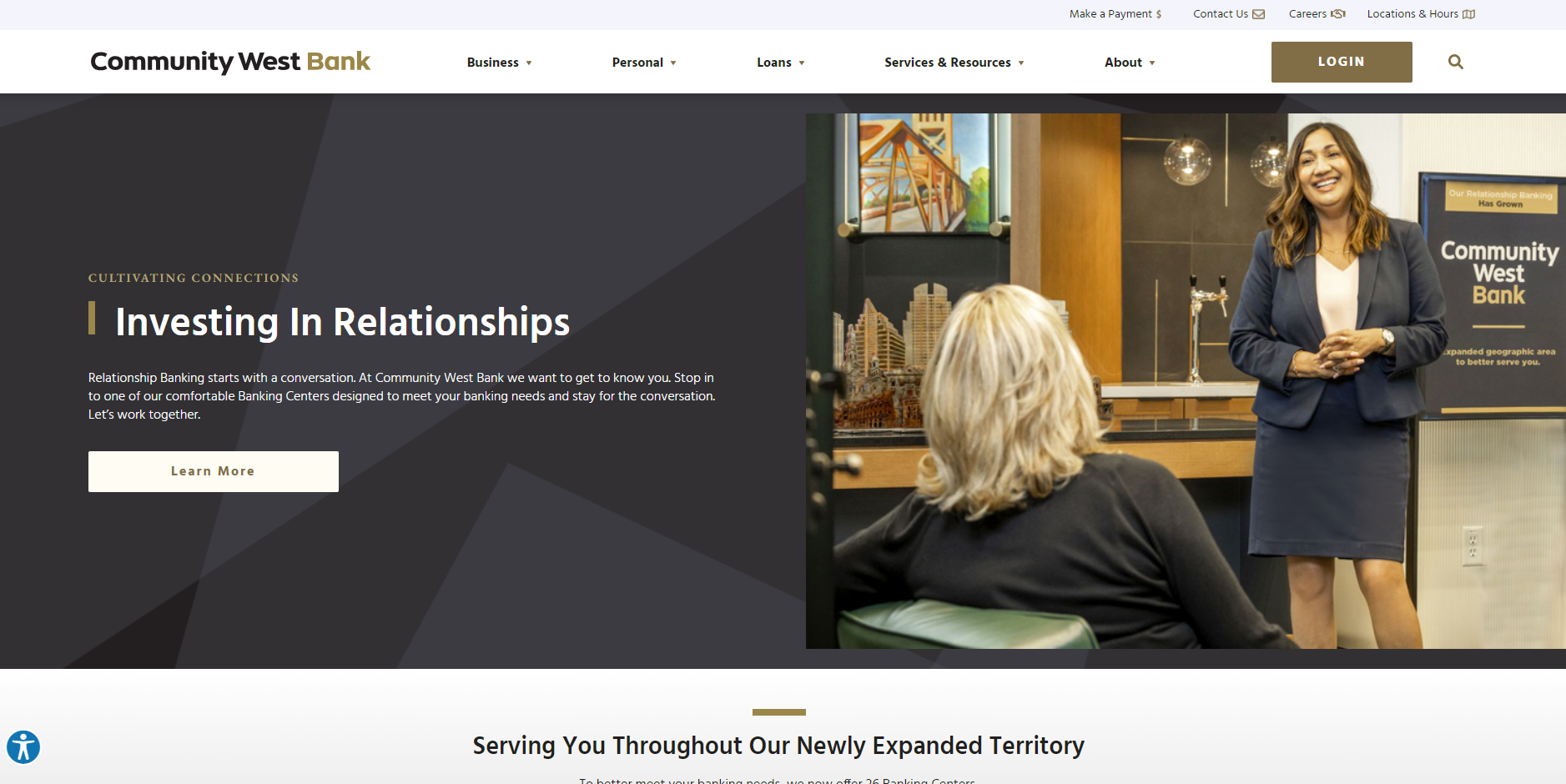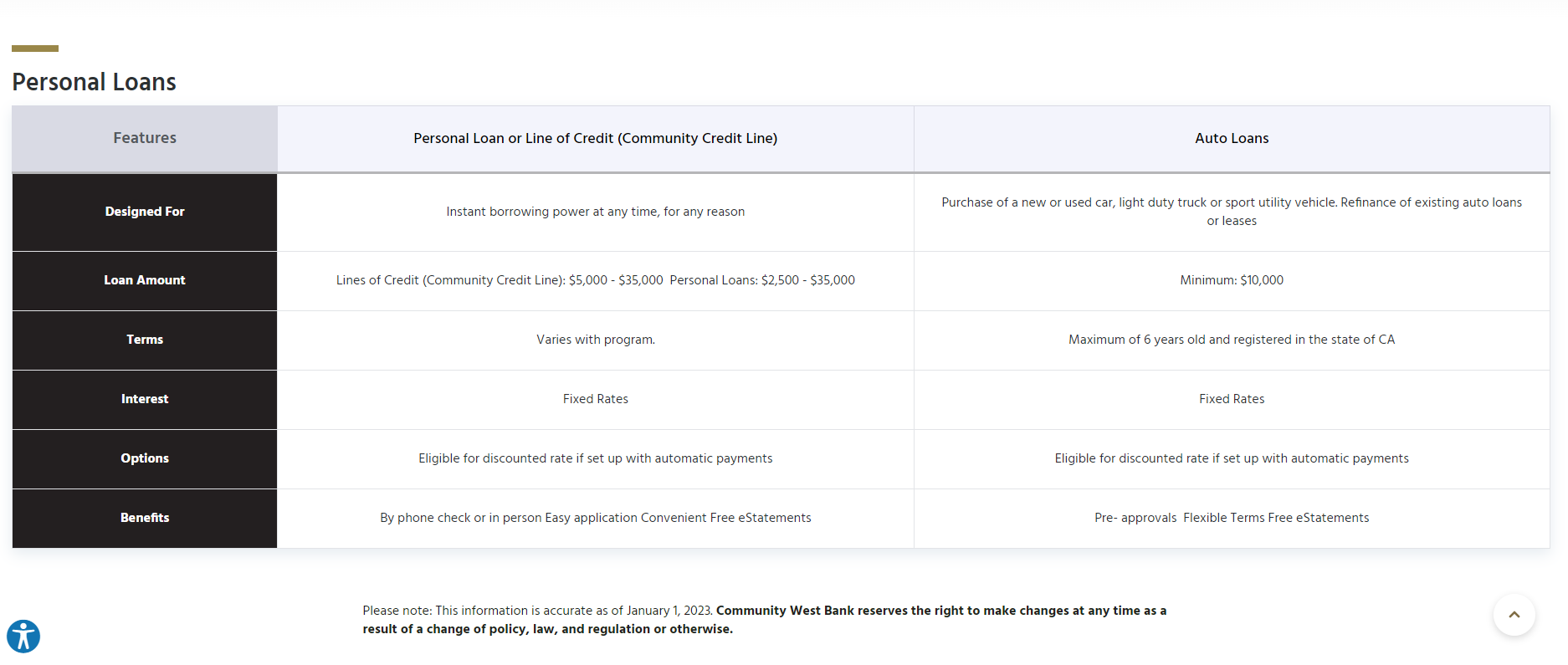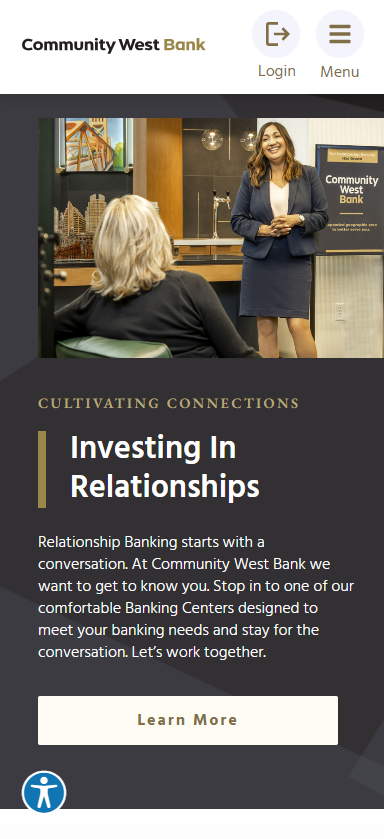Community West Bank
Services we provide:
- Discovery
- Strategy
- UX/UI design
- Website development
- Xperience by Kentico implementation
About Community West Bank
CWB is a large community bank in southern California with over 20+ locations and a track record of financial strength, security and stability gained over its 44 years in business. CWB has set itself apart from other banks by its people, dedication to client advocacy, exemplary "relationship banking," strong community support and a mission to exceed expectations. With a passion for providing customized solutions, the merger drove the decision to revamp their digital services to better serve their customers.
The Process
In an era where digital presence is critical to financial institutions and mergers are frequent, the successful merger of Community West Bank (CWB) and Central Valley Bank (CVB) depended on a robust and well-executed digital strategy, critical to providing a seamless user experience for customers and employees. SilverTech, leveraging its expertise in Xperience by Kentico website development, customized a digital solution that unified the brands of these two banks into one cohesive user-friendly digital experience in just 4 months from start to launch.
The Challenges
The merger of CWB and CVB presented unique challenges, particularly in integrating two distinct digital landscapes into a single cohesive website. The biggest challenges included:
- Differing Content Strategies: CWB's site was optimized for SEO with a rich content library, while CVB's site focused more on detailed product pages. Balancing these different content approaches was crucial.
- Short Timeline: The project needed to be completed with a demanding timeline, delivering a high-quality, functional website, from planning to launch in less than four months.
- Outdated Technology: The old CWB site suffered from poor mobile optimization, slow speeds, outdated information, and a lack of interactive features. This hindered customer engagement and usability.
Goals for New Site
SilverTech identified four main goals for CWB's new website with the main goal of unifying the brands. The merger of the two banks presented a unique opportunity to take advantage of the best from both brands.
Solution and Implementation
Based on the insight gained, SilverTech devised a comprehensive strategy roadmap to address the challenges and deliver a seamless digital experience for the bank merger. It was SilverTech's recommendation that Kentico's newest hybrid CMS platform Xperience by Kentico would be the best solution for the new website. Xperience with robust features and functionality allowed SilverTech to create an exceptional digital user experience efficiently for CWB.
The Key components of the solution include:
- Unified Content Strategy: SilverTech developed a content migration plan that combined the SEO-rich content from CWB with the detailed product information from CVB. This approach ensured that the new site would benefit from both banks' strengths while avoiding duplication and inconsistencies.
- Modern Design and Functionality: The new website was built with Xperience by Kentico, featuring a modern, responsive design to enhance user experience across all devices. Key features included:
- Enhanced Interactivity: Interactive elements and engaging content to improve customer interaction and retention
- Improved CTAs: Clear, strategically placed CTAs to guide users through the site effectively
- Technical Upgrades: Faster loading speeds, improved reliability, and mobile optimization to ensure a smooth user experience
- New Functionalities: Inclusion of essential tools like product comparison tools, branch locator and more
- Accelerated Development Timeline: Despite the tight timeline, SilverTech employed agile development practices to ensure timely delivery without compromising quality. The team worked in sprints to continuously test and refine the site, leading up to a successful launch within the four-month timeframe.
HIGHLIGHTS
The California Invasion of Privacy Act
By: Paul Creme | 3/19/25
A recent blog post on our website discussed the increase in the number of states that have adopted several types of privacy statutes modeled after the California Privacy Rights Act (“CPRA”).
There is another statute not as well-known and more limited in scope that companies should also be aware of. It is the California Invasion of Privacy Act (“CIPA”). At this time, it may only impact companies that are located within the state of California, but just as the CPRA applies to a resident in the state of California, the CIPA applies as well if the person accessing your website is a resident of California.
The reason for an increase in threatened actions based on the CIPA is that unlike the CPRA, the former allows for statutory damages of $5,000.00 per person. Some of the demand letters not only threaten legal action, but may become class actions suits, thus increasing the amount of damages. A class of a few hundred people could be a significant exposure.
The basis of the potential litigation is an invasion of privacy by using cookies and/or other website tracking technologies on the website. The argument is that these tracking technologies are an unwelcome invasion of a user’s privacy, like eavesdropping on a private conversation.
Numerous third-party applications integrate with websites to monitor, analyze, and optimize user interactions. Tools like Google Analytics and Hotjar track user behavior, session recordings, and engagement metrics to provide insights into website performance. Additionally, social media tracking pixels such as those from Facebook (Meta) and X (formerly Twitter), collect data on user interactions to enable personalized advertising, retargeting, and content optimization. Other analytics platforms, heat mapping tools, and behavioral tracking services further enhance a businesses’ ability to refine user experiences and improve marketing effectiveness. It is crucial to know which platforms will align with your business’s industry regulations such as HIPAA compliance laws.
The main issue under the CIPA is the absence of consent to using tracking technology. The use of a pen register, a “recording’ of the user’s interactions with the website amount, without a court order or explicit consent is illegal.
While the law remains unsettled, it will not stop the possibility of receiving a demand letter from an aggressive law firm, similar to the cases a few years ago about access under the Americans with Disabilities Act demanding that your company settle or face potential litigation.
The question is, what should a company do now to shield itself from a claim, or at least have a viable defense to a claim?
First, review terms of use and privacy policies that specifically deal with the use of website tracking technology with your legal counsel. Second, review how your company handles the information. Go beyond privacy statues and take inventory of what is on your website and determine if there is any tracking technology. Third, determine whether the tracking technology is critical to the operation of the company. If not, think about disabling it. Finally, make sure that opt out language is clear and allows the user to either opt out or block the tracking.
Please note this not intended to be legal advice and we cannot provide the language best suited to your particular company. This is something you need to work on with your legal counsel, but we can assist in evaluating and perhaps minimizing the potential risk. Contact us if you would like to learn more.



